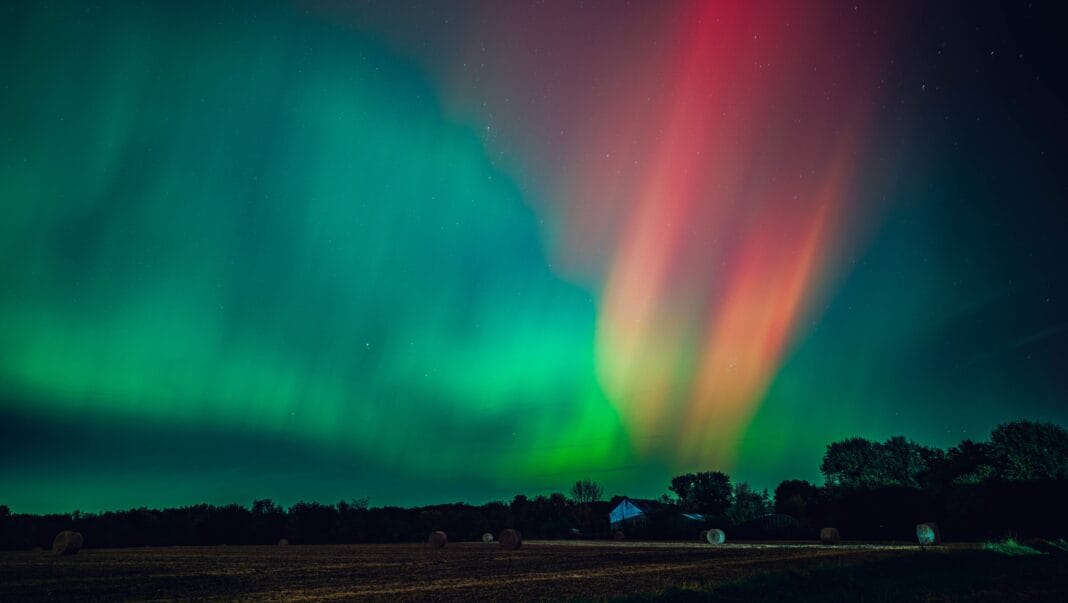The Captivating Dance of the Aurora Borealis: A Cosmic Wonder
Have you ever looked up at the night sky and hoped for something extraordinary to take your breath away? Last month, the cosmos delivered just that. Thanks to a geomagnetic storm that swept across the globe, people from cities far and wide had the chance to witness the breathtaking aurora borealis. This striking natural phenomenon painted the skies with hues of pink and green, transforming ordinary evenings into magical experiences.
Witnessing a Cosmic Marvel
The northern lights, typically a spectacle confined to the polar regions, made their presence felt as far south as New York City and Chicago, captivating the hearts of skywatchers everywhere. On October 10, the heavens lit up, displaying vibrant colors that seemed almost otherworldly. From the shores of California to the bustling streets of New Jersey, lucky observers experienced the dazzling display of nature’s artistry.
While many Americans reveled in the beauty of this cosmic event right from their backyards, some places, particularly in the northern states, offered an even clearer and more vivid view. Locations in Alaska, Washington, Idaho, Montana, North Dakota, Minnesota, Michigan, and Wisconsin were among the best spots to experience the full grandeur of the aurora borealis.
Celebrity Excitement on Social Media
The event was so captivating that it even caught the attention of celebrities. Kevin Jonas, known for his vibrant personality and love for the outdoors, shared his awe on social media. “How am I seeing this right now?” he captioned a stunning photo of the lights on his Instagram, echoing the sentiments of many who couldn’t believe their eyes. The aurora had not only dazzled the general public but had also sparked joy and wonder among some of the most recognizable faces in entertainment.
The Mystery of Visibility
As the excitement grew, so did the question of how long the northern lights would adorn the skies. Experts from the Space Weather Prediction Center at the National Oceanic and Atmospheric Administration (NOAA) indicated the possibility of another viewing opportunity on October 11. However, they cautioned that the clarity may not be as remarkable as the previous night. Skywatchers were advised that the further north they traveled, the better the chances of seeing the spectacular pink and green display again. Areas like Upstate New York and parts of Canada were expected to host an impressive visual treat.
The Best Time for Viewing
Timing plays a crucial role in witnessing the northern lights. Predominantly, the sweet spot for viewing is between 10 p.m. and 2 a.m. However, many fortunate viewers reported seeing the enchanting lights as early as 8 p.m. Those hoping to see this natural wonder were encouraged to venture outdoors shortly after sunset, embracing the mystery of the night sky.
A Final Reflection on Nature’s Beauty
The recent aurora borealis event serves as a reminder of the splendor that exists beyond our daily lives. It illustrates the incredible unpredictability of nature and the transient beauty found within its phenomena. Whether you were one of the lucky individuals who caught the glittering display or are simply captivated by the tales surrounding it, these cosmic marvels inspire us to look up, appreciate, and engage with the skies above.
FAQs
1. What causes the aurora borealis?
The aurora borealis is caused by the interaction of solar wind, a stream of charged particles from the sun, with the Earth’s magnetic field and atmosphere.
2. Can the aurora be seen in places other than the poles?
Yes! During strong geomagnetic storms, the aurora borealis can be seen further south than its usual range, as experienced recently in parts of the U.S. and Europe.
3. When is the best time to view the northern lights?
The best time to see the northern lights is typically between 10 p.m. and 2 a.m., though sightings can occur earlier in the evening.
4. Why do the lights have different colors?
The colors of the aurora borealis depend on the type of gas particles in the atmosphere. Oxygen produces green and red hues, while nitrogen gives off blues and purples.
5. Is the aurora borealis visible year-round?
While the aurora borealis can occur at any time, it is usually more visible during the winter months when nights are longer and darker.
6. Do you need special equipment to see the northern lights?
No special equipment is necessary, although warm clothing and a comfortable spot away from city lights can enhance the experience.
7. How can I track aurora forecasts?
Aurora forecasts can be tracked through websites and apps dedicated to space weather updates, including the Space Weather Prediction Center.
8. Are there tours available for viewing the aurora?
Yes! Many tour companies offer guided trips to the best viewing locations, particularly in Alaska, Canada, and Scandinavia.
9. How long do geomagnetic storms last?
Geomagnetic storms can last from a few hours to several days, affecting aurora visibility during their duration.
10. Where can I get updates on aurora events?
You can follow updates on aurora events through social media platforms, dedicated astronomy websites, and by visiting resources like cinerecap.
For more stunning experiences and insights into nature’s amazing phenomena, don’t forget to check your streaming options on Netflix, Prime Video, Hotstar, and Zee5 for documentaries and shows that celebrate these incredible natural events!

